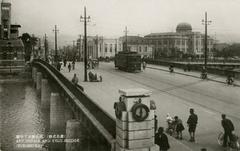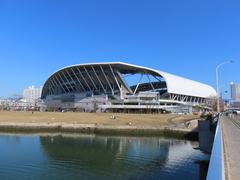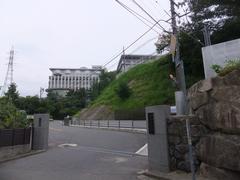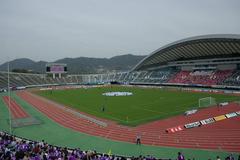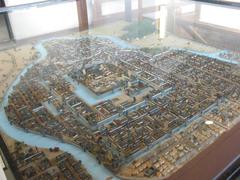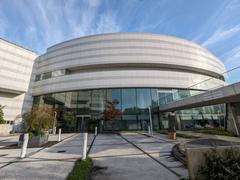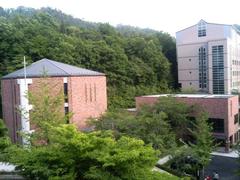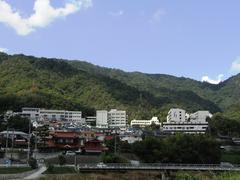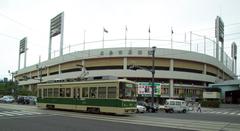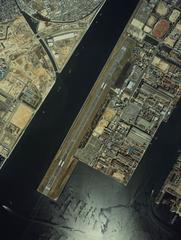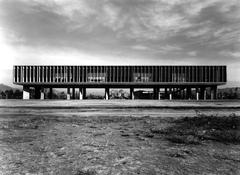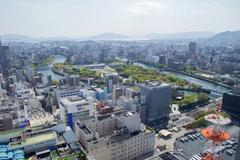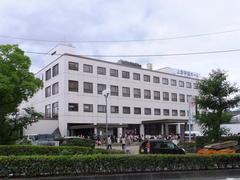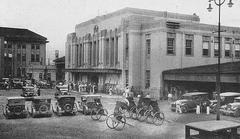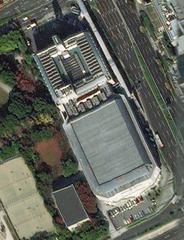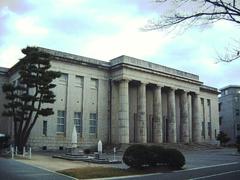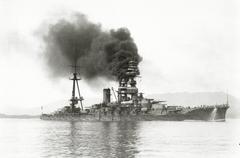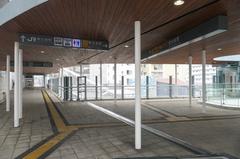
Hiroshima Prefectural Industrial Promotion Hall (Atomic Bomb Dome): Visiting Hours, Tickets, and Historical Significance
Date: 04/07/2025
Introduction
The Hiroshima Prefectural Industrial Promotion Hall—known worldwide as the Atomic Bomb Dome or Genbaku Dome—stands as a haunting symbol of the devastation of August 6, 1945, when Hiroshima became the first city ever attacked with an atomic bomb. Originally designed in 1915 by Czech architect Jan Letzel, this building was nearly beneath the bomb’s hypocenter and, remarkably, its skeletal frame survived while the surrounding city was destroyed. As a UNESCO World Heritage Site since 1996, the Dome is an enduring call for peace and a reminder of the catastrophic consequences of nuclear weapons. This guide details Hiroshima Prefectural Industrial Promotion Hall visiting hours, tickets, historical context, travel tips, nearby attractions, and how to plan a meaningful visit.
For up-to-date visitor information, consult the Hiroshima Peace Memorial Museum official website, Japan Guide, and Explore Hiroshima.
Table of Contents
- Introduction
- Historical Background
- Visiting the Hiroshima Peace Memorial
- Travel and Accessibility Tips
- Nearby Attractions
- Visitor Etiquette and Emotional Impact
- FAQ
- Conclusion
Historical Background
Origins and Early History
The building, originally the Hiroshima Prefectural Commercial Exhibition Hall, was completed in 1915 and later renamed the Prefectural Industrial Promotion Hall in 1933. Jan Letzel’s design incorporated Western architectural styles, making the hall a prominent landmark and hub for local industry and culture (Wikipedia).
Hiroshima’s Strategic Importance Before 1945
By the early 20th century, Hiroshima had developed as a military and economic hub. It housed army headquarters during World War II, and its infrastructure, including Ujina Port, contributed to its strategic value (Hiroshima Prefecture).
The Atomic Bombing of Hiroshima
On August 6, 1945, the US B-29 bomber Enola Gay dropped the atomic bomb “Little Boy” over Hiroshima, with the Dome situated just 160 meters from the hypocenter. The blast instantly killed tens of thousands, with the death toll reaching 140,000 by the end of the year due to injuries and radiation (History Skills; Wikipedia). The building’s steel skeleton survived, and its preservation has become a symbol of both destruction and hope.
Visiting the Hiroshima Peace Memorial
Visiting Hours and Tickets
- Atomic Bomb Dome: The Dome is an outdoor monument and accessible 24 hours a day, year-round. No ticket or reservation is required to visit or walk around the perimeter (Japan Guide; Any Travel Tips).
- Hiroshima Peace Memorial Museum: Open typically from 8:30 AM to 6:00 PM (may vary seasonally), with last admission 30 minutes before closing. Admission fee is 200–500 yen depending on age group (Japan Guide).
- Guided Tours: Free guided walking tours are often provided by Hiroshima Peace Volunteers. Audio guides are available for a small fee at the museum (Jasumo).
Best Times to Visit
- Early Mornings & Evenings: Quieter and more contemplative, with softer light ideal for photography.
- Peak Seasons: Weekends, midday, and cherry blossom season (mid-March to mid-April) are busier (Any Travel Tips).
- August 6th: The annual Peace Memorial Ceremony draws large crowds and dignitaries; plan ahead if visiting on this day (Japan Guide).
Travel and Accessibility Tips
Getting There
- From Hiroshima Station: Take tram line 2 (Miyajima Line) or line 6 (Eba Line) to Genbaku Dome-mae. The ride is about 15 minutes and costs 240 yen (Japan Guide; Trip to Japan).
- By Bus: The Hiroshima Sightseeing Loop Bus (Meipuru-pu) stops at the Peace Memorial Park area.
Accessibility
- The park and Dome area are wheelchair accessible, with paved paths and ramps (Dive! Hiroshima). Public restrooms and the museum are also barrier-free.
Parking
- No dedicated lot at the Dome, but public parking is available nearby, including at the Hiroshima Prefectural Industrial Hall (Dive! Hiroshima).
On-Site Experience and Visitor Etiquette
What to Expect
- The Dome is fenced off for preservation, but visitors can walk the perimeter and read multilingual information boards (Japan Guide; World Heritage Site).
- The surrounding Peace Memorial Park contains many other memorials and is a tranquil space for reflection (Explore Hiroshima).
Conduct and Sensitivity
- Speak quietly, avoid disruptive behavior, and be mindful when taking photos.
- Leaving paper cranes is a common gesture of peace, inspired by Sadako Sasaki’s story (The Broke Backpacker).
Nearby Attractions and Amenities
- Hiroshima Peace Memorial Museum: Moving exhibits, survivor testimonies, and artifacts (Japan Guide).
- Children’s Peace Monument: Honoring Sadako Sasaki and child victims (Trip to Japan).
- Memorial Cenotaph: Arched monument with the names of all known victims.
- Peace Bell & Flame of Peace: Symbols of hope for nuclear disarmament.
- Rest House: Café, tourist information, souvenir shop, and restrooms (Dive! Hiroshima).
Nearby, Hiroshima’s downtown offers a variety of restaurants, including those specializing in okonomiyaki.
Emotional Impact and Reflection
Standing before the Dome often evokes a profound sense of sorrow and contemplation about the past and the ongoing quest for peace. The site’s quiet atmosphere and the presence of survivors and students from around the world make this a powerful place for reflection (Japambience).
Special Events and Anniversaries
- Peace Memorial Ceremony (August 6th): Annual event with speeches, a moment of silence at 8:15 AM, and the release of paper lanterns (Dive! Hiroshima).
- Seasonal Highlights: Cherry blossoms in spring, autumn foliage, and special exhibitions at the museum.
Frequently Asked Questions (FAQ)
Do I need tickets to visit the Atomic Bomb Dome?
No, access is free and open 24/7. Tickets are only required for the museum.
What are the Atomic Bomb Dome visiting hours?
The Dome is accessible at all hours; the museum typically operates from 8:30 AM to 6:00 PM (seasonal variations apply).
Is the Dome wheelchair accessible?
Yes, as are the park and museum.
Are guided tours available?
Yes, guided walks and audio guides are available—check the official museum website for details.
When is the best time to visit for cherry blossoms?
Mid-March to mid-April.
How do I reach the Dome from Hiroshima Station?
Take tram lines 2 or 6 to Genbaku Dome-mae.
Can I take photographs at the Dome?
Yes, but please be respectful; some museum areas restrict photography.
Visuals and Maps
- High-quality image suggestion: Atomic Bomb Dome at sunrise with the city skyline in the background.
Alt text: “Atomic Bomb Dome visiting hours at sunrise in Hiroshima historical site.” - Map suggestion: Route from JR Hiroshima Station to Genbaku Dome-mae.
- Virtual tour suggestion: Embedded video of Peace Memorial Park and Dome.
Conclusion
The Hiroshima Prefectural Industrial Promotion Hall (Atomic Bomb Dome) is a vital destination for anyone seeking to understand the history and human cost of nuclear warfare. Open 24/7 and free to visit, the Dome and its surrounding park invite quiet reflection and offer a deeply moving experience. Whether you are interested in history, peace advocacy, or cultural heritage, planning your visit with respect and awareness—of both the site’s significance and practical details—ensures your time in Hiroshima is meaningful and memorable.
For guidance, itineraries, and audio tours, download the Audiala app and follow us for the latest updates on Hiroshima’s historical and cultural sites.
Sources
This article draws upon the following authoritative resources, which you can consult for more information:
- Wikipedia: Hiroshima Peace Memorial (Atomic Bomb Dome)
- Hiroshima Prefecture Peace and Reconstruction
- Explore Hiroshima: Genbaku Dome
- Japan Guide: Hiroshima Peace Memorial
- World Heritage Site: Genbaku Dome
- Hiroshima Peace Memorial Museum Official Website
- Trip to Japan: Visiting the Atomic Bomb Dome and Museum
- Dive! Hiroshima: Visitor Experiences and Tips
- Jasumo: Visitor Guide
- Japan Travel Note: Visitor Experiences
- The Broke Backpacker: Hiroshima Itinerary and Tips
- Any Travel Tips: Photography and Visiting Tips









































